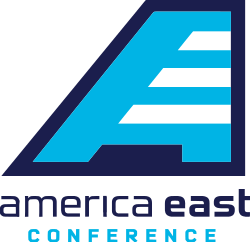University of New Hampshire
 | |
| Motto | Science, Arts, Industry |
|---|---|
| Type |
Public Flagship Sea grant Land grant Space grant |
| Established | 1866 |
| Endowment | $336 million[1] |
| President | Mark W. Huddleston (19th) |
Administrative staff | 586 |
| Students | 15,340[2] |
| Undergraduates | 12,840[3] |
| Postgraduates | 2,500 |
| Location | Durham, Concord, and Manchester, New Hampshire, U.S. |
| Campus |
Rural 2,600 acres |
| Colors |
Blue and White[4] |
| Athletics | NCAA Division I – America East, Hockey East |
| Nickname | Wildcats |
| Mascot | Wild E. Cat |
| Affiliations |
University System of New Hampshire APLU |
| Website |
www |
 | |
The University of New Hampshire (UNH) is a public research university in the University System of New Hampshire, in the United States. The university's Durham campus, comprising six colleges, is located in the Seacoast region of the state. A seventh college, the University of New Hampshire at Manchester, occupies the university's campus in Manchester, the state's largest city. The University of New Hampshire School of Law, known as the Franklin Pierce Law Center until 2010, is located in Concord, the state's capital.
The University of New Hampshire was founded and incorporated in 1866, as a land grant college in Hanover in connection with Dartmouth College. In 1893, UNH moved to Durham.
With over 15,000 students between its Durham, Manchester, and Concord campuses, UNH is the largest university in the state. The university is one of only nine land, sea and space grant institutions in the nation. Since July 1, 2007, Mark W. Huddleston has served as the university's 19th president.
UNH was one of 15 highest scoring schools on the College Sustainability Report Card 2009, with the Sustainable Endowments Institute awarding it a grade of "A-".[5] In 2012, UNH was named the 6th "coolest school" in the country by Sierra magazine for its efforts in sustainability.[6]
History
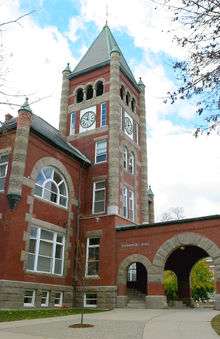
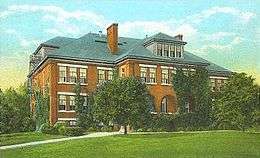
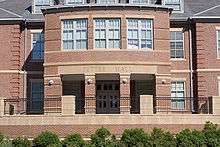
The Morrill Act of 1862 granted federal lands to New Hampshire for the establishment of an agricultural-mechanical college. In 1866, the university was first incorporated as the New Hampshire College of Agriculture and the Mechanic Arts in Hanover, New Hampshire, in association with Dartmouth College. The institution was officially associated with Dartmouth College and was directed by Dartmouth's president. Durham resident Benjamin Thompson left his farm and assets to the state for the establishment of an agricultural college. On January 30, 1890, Benjamin Thompson died and his will became public. On March 5, 1891 Gov. Hiram Americus Tuttle signed an act accepting the conditions of Thompson's will. On April 10, 1891, Gov. Tuttle signed a bill authorizing the college's move to Durham, New Hampshire.
In 1892, the Board of Trustees hired Charles Eliot to draw a site plan for the first five campus buildings: Thompson, Conant, Nesmith, and Hewitt Shops (now called Halls) and the Dairy Barn. Eliot visited Durham and worked for three months to create a plan prior to the move to Durham. The Class of 1892, excited about the pending move to Durham, held commencement exercises in an unfinished barn on the Durham campus. On April 18, 1892, the Board of Trustees voted to "authorize the faculty to make all the arrangements for the packing and removal of college property at Hanover to Durham." The Class of 1893, followed the previous class and held commencement exercises in unfinished Thompson Hall, the Romanesque Revival campus centerpiece designed by the prominent Concord architectural firm of Dow & Randlett.
In fall 1893, classes officially began in Durham with 51 freshmen and 13 upperclassmen, which was three times the projected enrollment. Graduate study was also established in fall 1893 for the first time. The number of students and the lack of state funds for dormitories caused a housing crunch and forced students to find housing in town. The lack of housing caused difficulty for attracting women to the university. In 1908, construction on Smith Hall, the first women's dorm, was completed using private and state funds. Prior to the construction of Fairchild Hall in 1915 for male students, 50 freshmen lived in the basement of DeMerritt Hall. With the continuing housing shortage for men, the administration encouraged the growth of the UNH Greek system. From the late 1910s through the 1930s, the fraternity system expanded and provided room and board for male students.
In 1923, Gov. Fred Herbert Brown signed a bill changing the name of the college to University of New Hampshire.
Academics
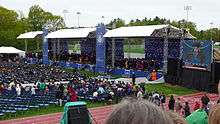
The University of New Hampshire is the flagship of the University System of New Hampshire. UNH is composed of eleven colleges and graduate schools, offering 2,000 courses in over 100 majors. The eight colleges of UNH are:
- College of Engineering and Physical Sciences (CEPS)
- College of Liberal Arts (COLA)
- College of Life Sciences and Agriculture (COLSA)
- Thompson School of Applied Science (TSAS)
- College of Health and Human Services (CHHS)
- University of New Hampshire at Manchester (UNHM)
- UNH Graduate School
- Peter T. Paul College of Business and Economics (PCBE), formerly the Whittemore School of Business and Economics (WSBE)
- University of New Hampshire School of Law
- Carsey School of Public Policy
- School of Marine Science and Ocean Engineering
The university is a member of the New England Board of Higher Education's New England Regional Student Program (NERSP) where New England public universities and colleges offer a number of undergraduate curricula with special considerations to students from other New England states. If an out-of-state student's home state school does not offer a certain degree program offered by UNH, that student can receive the in-state tuition rate, plus 75 percent if enrolled in the program.
The Thompson School of Applied Science (TSAS), first established in 1895 and now a division of COLSA, confers an associate degree in applied science in seven different programs: Applied Animal Science, Applied Business Management, Civil Technology, Community Leadership, Food Service Management, Forest Technology, and Horticultural Technology.
The coastal proximity of the university affords excellent programs in marine biology and oceanography. Facilities include the Jackson Estuarine Laboratory at Adams Point in Durham, and the Shoals Marine Laboratory jointly operated with Cornell University on Appledore Island in the Isles of Shoals.
The University of New Hampshire Observatory is operated by the Department of Physics for educational purposes.
There are three main university-wide undergraduate research programs: Undergraduate Research Opportunities Program (UROP), Undergraduate Research Fellowship (SURF), and International Research Opportunities Program (IROP).
The university offers many opportunities for students to study abroad through managed programs, exchange programs and approved programs. As of fall 2004, there were 561 students (4 percent of the student body) studying in 38 different countries. The university runs/manages 22 study abroad programs in locations which include Cambridge, England; London, England; Edinburgh, Scotland; Brest, France; Dijon, France; Grenoble, France; Budapest, Hungary; Osaka, Japan; Utrecht, Netherlands; Maastricht, Netherlands; Ascoli Piceno, Italy; New Zealand; India; South Africa; Kenya; and Granada, Spain. The university also accepts credit from over 300 approved programs that are run through other institutions. The university organizes an annual summer abroad program at Gonville and Caius College, Cambridge University. There are also over 100 National Exchange Program opportunities.
In 2010, the Franklin Pierce Law Center in Concord was incorporated into the University of New Hampshire System and renamed the University of New Hampshire School of Law. It is the only law school in the state of New Hampshire. The School of Law offers Juris Doctor degrees in addition to graduate studies in Intellectual Property and Commerce & Technology. The University of New Hampshire Law School is renowned for its intellectual property law programs, consistently ranking in the top ten of U.S. News & World Report rankings. In 2012, it was ranked 4th behind University of California at Berkeley, Stanford University and George Washington University.
The Peter T. Paul College of Business and Economics building was opened for occupancy in January 2013.[7] Formerly the Whittemore School of Business and Economics (WSBE), the Paul School offers degrees[8] in Business Administration (featuring focuses in Accounting, Entrepreneurial Venture Creation, Finance, Information Systems Management, International Business and Economics, Management, and Marketing), Hospitality, and Economics (either in B.A. or B.S.[8])
As of the 2015 fall semester, the university had 12,840 undergraduate students and 2,500 graduate students enrolled in more than 200 majors. The student body comprises 47% in-state students, 49% out-of-state students, and 4% international students; and is 54% female and 46% male.[9]
Rankings
| University rankings | |
|---|---|
| National | |
| ARWU[10] | 103-125 |
| Forbes[11] | 201 |
| U.S. News & World Report[12] | 107 |
| Washington Monthly[13] | 215 |
| Global | |
| ARWU[14] | 301-400 |
| QS[15] | 601-650 |
| U.S. News & World Report[16] | 486 |
U.S. News & World Report ranks New Hampshire (tied for) 107th among 280 "national universities."[17]
In 2012, the Department of Education ranked the University of New Hampshire as having the sixth most expensive in-state tuition for a public four-year college.[18] The University of New Hampshire ranks lowest in the country for the amount of subsidy it receives from the state.[19]
Research
The university is classified as one of the "Doctoral Universities: Higher Research Activity" in the Carnegie Classification of Institutions of Higher Education.
University Library
The University Library consists of the main Dimond Library and three science libraries specializing in chemistry, physics, and computer science, mathematics, and engineering.[20] The Dimond Library has three quiet study reading rooms, seating for 1,200, Zeke’s café, and the Dimond Academic Commons (DAC). It offers reference assistance, IT help, and media equipment, as well as collaborative work spaces, computer workstations, and laptop ports throughout the building.[21]
The Chemistry Library (Parsons Hall), the Engineering/Mathematics/Computer Science Library (Kingsbury Hall), and the Physics Library (DeMeritt Hall) offer customized service for the UNH scientific and engineering communities. Each science library offers specialized reference assistance, reserve materials, reference and circulating collections, periodicals, and electronic resources specific to their fields. All science libraries provide WiFi and laptop ports, laptops and computer workstations, as well as other equipment. Parsons, DeMeritt and Kingsbury Libraries have group meeting rooms that students may reserve; all have collaborative as well as quiet areas.
In addition to more than 2 million volumes and 50,000 periodical subscriptions, the library has an extensive government documents collection, maps, sound recordings, CDs, videos, DVDs, and a Special Collections and Archives section with rare books, manuscripts, and University publications and papers. The Library offers extensive electronic resources including e-books, digital collections, indexes in many subject areas, statistical data sets and databases supplying full-text periodical and newspaper articles.
University of New Hampshire InterOperability Laboratory (UNH-IOL)
Students and staff, mainly belonging to majors of Electrical Engineering, Computer Engineering, and Computer Science students work at the UNH InterOperability Laboratory, which tests networking and data communication devices and products. The UNH-IOL interviews and accepts applications from students of all majors and varying backgrounds of job experience and expertise.[22]
More than 100 graduate and undergraduate student employees work with full-time UNH-IOL staff, gaining hands-on experience with developing technologies and products. The companies and organizations that work with the UNH-IOL benefit from cost-effective testing services, as well as the opportunity to recruit future engineers from the UNH-IOL workforce.[23]
Carsey School of Public Policy
The Carsey School of Public Policy at the University of New Hampshire conducts policy research on vulnerable children, youth, and families and on sustainable community development. They give policy makers and practitioners the timely, independent resources they need to effect change in their communities.[24]
Activities
The university has more than 200 student organizations grouped by academics and careers, community service, political and world affairs, arts and entertainment, culture and language, fraternities and sororities, hall councils, honor societies, leisure and recreation, media and publications, religious, special interest, and student activism. Recreation at the University of New Hampshire also includes club and intramural sports.
A list of these groups can be found on the Student Organization Services website.[25] Thirteen of these groups receive Student Activity Fee funds to help subsidize the services they provide; these groups include the Campus Activity Board, Diversity Support Coalition, Memorial Union Student Organization, The Granite yearbook, SCAN TV, Student Committee on Popular Entertainment, Non-Traditional Student Organization, Student Senate,[26] The New Hampshire, and WUNH.
The New Hampshire Outing Club, the oldest and largest club on campus, offers trips into the outdoors each weekend. There is also a Dairy Club for people interested in dairy cows and learning more about them.[27]
Student government
The University of New Hampshire Student Senate serves as an advocate for all undergraduate students, deriving its power from the consent of the student body; and is developed on the principle that all undergraduate students of the University of New Hampshire have the basic right and responsibility to participate in University governance.[28] Such participation encourages the development of student expertise in university affairs, and places significant responsibility on students for their involvement with the implementation of policies, rules, and regulations that affect the lives and quality of education of students at the University of New Hampshire.[29]
The New Hampshire: The official UNH newspaper
The New Hampshire is UNH's twice-weekly student newspaper. New issues appear every Monday and Thursday during the academic year.
Engineering
Engineering students have the opportunity to get involved in the following projects and extracurricular activities:
|
|
Greek life
Approximately 9.5%[34] of undergraduate students are affiliated with fraternities and sororities recognized by the university. The Office of Student Involvement and Leadership, the Interfraternity Council, Panhellenic Council, and the United Greek Association,[34] oversee the 12 recognized social fraternities, seven recognized social sororities, and one coed society. Many of the fraternities and sororities have houses on Madbury Road and Strafford Avenue in Durham. These houses are not owned by or on university property.
|
Fraternities |
Sororities |
Professional fraternities |
Unrecognized groups
Unrecognized groups that have no official relationship with the University of New Hampshire after losing recognition for violations of the Student Code include:
- Phi Kappa Theta
- Zeta Chi Beta
- Alpha Sigma Phi
- Phi Beta Gamma
- Sigma Beta
- Pi Kappa Alpha
Music
The University of New Hampshire offers two undergraduate degree programs: the Bachelor of Arts in music and the Bachelor of Music; and two graduate degree programs: the Master of Arts in music (concentrations in composition, conducting, and musicology), and the Master of Arts in teaching. The department also offers the following groups for one academic credit:
Instrumental
- Wind Symphony[36]
- Symphonic Band[36]
- Concert Band[36]
- Wildcat Marching Band[36]
- Beast of the East Pep Band[36]
- Jazz Bands[37]
- Symphony Orchestra[38]
Vocal
Student run—not associated with music dept
- Not Too Sharp[40]
- Alabaster Blue[41]
- University of New Hampshire Gentlemen
- University of New Hampshire Notables
- Maiden Harmony
- Off the Clef
- ASUM Klub
- Divertimento Chamber Orchestra
- UNH Winter guard
UNH also offers a music minor, which requires 20 credits from the music department. These credits must include one full year of theory and one full year of music literature.[42]
Athletics
The school's athletic teams are the Wildcats, and they compete in the NCAA Division I. New Hampshire is a member of the America East Conference for basketball, cross country, track and field, soccer, swimming & diving and tennis; and women's crew, field hockey, and volleyball. The women's gymnastics[43] program competes in the Eastern Atlantic Gymnastics League at the Division I level. They also compete in Hockey East in men's and women's ice hockey, Eastern Collegiate Ski Association for skiing, as well as the Colonial Athletic Association for football at the Football Championship Subdivision (FCS, formerly known as Division I-AA) level.
In the 2006 academic year the university cut women's crew, men's swimming & diving, and men's and women's tennis at the varsity level, and trimmed the size of the men's ski team from 27 to 12. Luckily the UNH men's ski team was not cut, as they remain one of the top powerhouse teams in the nation. In 2013, the men's alpine team placed second at the NCAA championships. The reason given was that the athletic department would save $500,000 towards a $1 million budget shortfall and be in compliance with Title IX for the first time.[44] In 1997, the university cut baseball, softball, men's and women's golf, and men's lacrosse.
In addition to varsity athletics, the university offers many club sports through the Department of Campus Recreation, including aikido, archery, baseball, crew, cycling, dance, fencing, figure skating, golf, lacrosse, Nordic skiing, rugby, sailing, softball, tennis, taekwondo, men and women's Ultimate Frisbee,[45] wrestling, and the Woodsmen Club. Many of these clubs compete either on an intercollegiate basis with New England teams, or sponsor university tournaments and frequently participate in national championships. UNH also offers horseback riding as a recreation. Many students can take horseback riding lessons with instructors, on their horse or the schools. UNH holds many events each year, for they have a large cross country course. UNH also has a dressage team and a hunt seat team that competes yearly.
The school's official colors are blue and white. The school's official mascot is the wildcat and its uniformed mascot is known as "Wild E. Cat".
The recognized fight song of UNH is "On to Victory", the most current version of which was arranged by Tom Keck, Director of Athletic Bands from 1998–2003. In 2003, "UNH Cheer" (originally titled "Cheer Boys") was resurrected from the university archives by Erika Svanoe, Director of Athletic Bands from 2003-2006.[46] Based on the school song "Old New Hampshire", not to be confused with the New Hampshire state song of the same name, "UNH Cheer" currently serves as a secondary fight song and is often performed immediately following "On to Victory".
On October 7, 2006, Wildcats wide receiver David Ball tallied the 51st receiving touchdown of his career to displace Jerry Rice of Mississippi Valley State University, who was inducted into the College Football Hall of Fame a month earlier, atop the ranking of NCAA Division I and I-AA players by career receiving touchdowns. He later signed as a rookie free agent with the Chicago Bears and played with well-known college football players Chris Leak and Darius Walker.
Durham campus
The University of New Hampshire is located in the town of Durham, and is a "traditional New England campus." The Durham campus is 1,100 acres (4.5 km2), with 300 acres (1.2 km2) in the "campus core" and 800 acres (3.2 km2) of open land on the west edge of campus. The campus core is considered to be the university property within a 10-minute walk from Thompson Hall, the symbolic and near-geographic center of campus. The campus core contains many of the academic and residential buildings, while the outer campus contains much of the agriculture land and buildings. The university owns a total of 2,600 acres (11 km2) of land.
Housing



The university offers all underclassmen the opportunity to live in university housing. As of 2006, the university housed 55% of all undergraduate students. While not required to live on campus freshman year, students are strongly encouraged to; as of the fall 2009 semester over 99% of incoming freshmen chose to live on campus, and over 70% of returning sophomores did as well.
The university offers students a choice of traditional dorm rooms, suites, and on-campus apartments. The university's Campus Master Plan envisions housing about 60% of undergraduates, requiring an addition of 1700 beds. However, the state of New Hampshire does not provide funding for non-academically related buildings, including dormitories.
Undergraduate housing is divided into three areas: The Hills, The Valley and The Timbers (formerly Area I, Area II and Area III, respectively). There are also two undergraduate apartment complexes, The Gables and Woodside Apartments. The university offers family housing in the Forest Park apartments and graduate housing in Babcock Hall. The second oldest dorm on campus is Hetzel Hall, named after the university's former president Ralph D. Hetzel. Built in 1925, it is located near downtown Durham.
For the fall 2006 semester, two new buildings at The Gables ("North" and "South") were opened, providing an additional 400 beds. In summer 2006, one-half of Forest Park was demolished to make way for two new buildings (A & B) of the Southeast Residential Community (SERC). Buildings SERC A and SERC B have provided housing for 492 students since fall 2007. Two existing mini-dorms were demolished during summer 2007 (leaving four more mini-dorms) to construct a third building, SERC C, which has provided housing for 235 students since fall 2008. SERC A, B, and C are now referred to as Handler, Peterson, and Haaland Hall. Plans exist to provide 781 new beds by demolishing the remaining 9 buildings (98 units) in Forest Park. Later plans call for the construction of a new 170-unit graduate housing facility at a location to be determined.
Due to the over-enrollment of the 2006–2007 academic year, the university offered students who intended to live in campus housing a free parking pass for the academic year, credit in UNH "Dining Dollars" and a refund of the housing deposit given that the student withdrew their intentions to live on campus. The incentive was designed to free up space for the large incoming freshman class.
Stoke Hall is the largest residence building on campus. It houses a little over 700 undergraduate students.[47]
In 2015, UNH installed life-saving automated external defibrillators in two fraternity houses.[48]
Themed housing
The University of New Hampshire offers themed housing options for students interested in choosing a living environment that best suits their personality. Common themes include: first year, leadership, green living, multi-cultural, honors, chem-free, alcohol and drug-free and the arts.[49]
Housing is guaranteed to all new first-year students, with many of them housed in Christensen Hall and Williamson Hall, the two largest first-year-only halls. Alexander Hall is also an all first-year student hall, specifically for students in the College of Liberal Arts who have not declared a major yet.[50] These halls offer a living environment of commonality, where all are new to the university. The university guarantees students who live on-campus the ability to live on campus all four years. However, students who move off campus (with the exception of students studying abroad) lose this guarantee, and must complete a housing wait-list application each semester in order to be considered for on-campus housing the following semester.[51]
Transfer students can generally get on campus housing if transferring to UNH for the spring semester (but must submit a completed housing wait-list application prior to transferring);[51] however, transfer students transferring for the fall semester have a relatively low chance of getting on campus housing due to the high demand of returning students, and the incoming freshman class. Transfer students are also not guaranteed housing, unless transferring from a community college after graduating with their associates.[51]
Sustainability
With the UNH Sustainability Institute, UNH possesses the oldest endowed sustainability program in higher education in the U.S. and has been integrating sustainability across the university's curriculum, operations, research and engagement since the office was founded in 1997.[52] Examples of efforts include:
- Dual major available in sustainability
- Dual major available in EcoGastronomy
- The first organic dairy research farm at a US land grant university
- EcoLine (a landfill gas pipeline) that meets up to 85% of the university's energy needs (while selling REC's off the electricity generated to invest back in the EcoLine project and a revolving energy efficiency fund)
- WildCAP, UNH's Climate Action Plan, with goals to reduce greenhouse gas emissions 50% by 2020 and 80% by 2050 (compared to a 1990 baseline)
- Energy and Ecosystem Task Forces
- Signature of the international Slow Food principles, the American College and University Presidents Climate Commitment, and the Taillories Declaration
- ~22% of dining hall purchases coming from local, regional and organic sources
- Engaged scholarship for sustainability through programs like Carbon Solutions New England, Food Solutions New England, the Sustainability Research Collaboratory, and more
- NH Farm to School Program[52][53]
UNH has received numerous awards and "top ten" recognition for its sustainability leadership, including from AASHE, the Sustainable Endowments Institute, the Princeton Review, the Sierra Club, KIWI Magazine, Business NH Magazine, the USEPA, and the USDOT.[54]
UNH released a book about its sustainability efforts in 2009, titled The Sustainable Learning Community: One University's Journey to the Future. Coauthored by over 60 faculty, staff and community partners, it is one of the first to focus on a higher education institute's entire suite of integrated sustainability efforts. The text cites university efforts to integrate sustainable behavior within its own educational structure, encouraging a critical outlook on local and global sustainability practices.[55]
Manchester campus

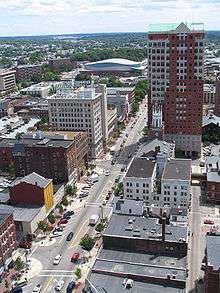
As of March 2015, University of New Hampshire at Manchester is located in the 110,000-square-foot (10,000 m2) Pandora Mill at 88 Commercial Street, on the banks of the Merrimack River in Manchester's historic Amoskeag Millyard. The move to 88 Commercial Street increased the physical plant of the college by almost 50%, as from 2001 to 2014 the school was located in the 75,000-square-foot (7,000 m2) University Center building at 400 Commercial Street.
National Historic Chemical Landmark
Conant Hall was dedicated as a National Historical Chemical Landmark—the first in New Hampshire. Conant Hall was the first chemistry building on the Durham campus, and it was the headquarters of the American Chemical Society from 1907–1911, when Charles Parsons was the society’s secretary. In addition, from 1906–1928, the hall housed the laboratories of Charles James, who was an innovative developer of separation and analytical methods for compounds of rare earth elements.[56] James Hall, the second chemistry building on campus, was named for Charles James.
Notable alumni
Notable alumni of the University of New Hampshire include world-renowned author John Irving (B.A. 1965), National Book Award-winning author Alice McDermott (M.A. 1968), filmmaker Jennifer Lee (B.A. 1992), and several former governors of the state of New Hampshire.
Notable faculty
- Grant Drumheller, painter, Professor of Art
- Meredith Hall, author of New York Times bestseller Without a Map, Lecturer of English
- Jochen Heisenberg, Professor Emeritus of Physics, son of famed German physicist and Nobel Laureate Werner Heisenberg
- Rochelle Lieber, linguist, Professor of English
- John D. Mayer, Professor of Psychology, co-developer of Mayer-Salovey-Caruso Emotional Intelligence Test (MSCEIT) and notable author and expert on personality psychology
- Joshua Meyrowitz, author of No Sense of Place, Professor of Communication
- Robert Morin, Dimond Library cataloger who donated his four million dollar estate to the university after his death in 2015
- Donald Murray, Pulitzer Prize-winning journalist, Professor Emeritus of English
- Edwin Scheier, sculptor, Fine Art professor emeritus
- Mary Scheier, sculptor, Artist-in-residence emeritus
- Charles Simic, Pulitzer Prize-winning poet, Professor of English, U.S. Poet Laureate (2007–08)
- Clark Terry, jazz trumpeter, affiliate faculty, Department of Music (1988-2015)[57]
- Stacy D. VanDeveer, political scientist, Professor of Political Science and Chair of the Department of Political Science
- Yitang Zhang, number theorist, Professor of Mathematics, MacArthur Fellow
Campus sites of interest
- Durham-UNH (Amtrak station)
- Jesse Hepler Lilac Arboretum
- UNH Museum of Art[58]
- UNH Dairy Bar (ice cream served by UNH students in historic train depot)[59]
- Whittemore Center, home to UNH Wildcat men's and women's hockey. Capacity is 6,501 for sporting events, 7,500 for concerts and other events.
- Lundholm Gymnasium, home to UNH Wildcat men's and women's basketball and women's gymnastics
- Wildcat Stadium, home to UNH Wildcat football
- Thompson Hall, first structural home of the University of New Hampshire[60]
- Memorial Union Building (MUB)
See also
References
- ↑ http://usnews.com/best-colleges/university-of-new-hampshire-2589
- ↑ "About UNH". Retrieved 11 Jan 2016.
- ↑ "About UNH". Retrieved 11 Jan 2016.
- ↑ "Visual Identity Standards" (PDF). October 28, 2015. Retrieved April 9, 2016.
- ↑ "College Sustainability Report Card 2009". Sustainable Endowments Institute. Retrieved June 5, 2009.
- ↑ Andrews, Avital. "The Top 10 America's Coolest Schools". Retrieved 2 April 2013.
- ↑ "Paul College of Business and Economics". University of New Hampshire.
- 1 2 "Undergraduate Course Catalog". University of New Hampshire. Retrieved 2 April 2013.
- ↑ "Demographics". University of New Hampshire Institutional Research. Retrieved November 10, 2015.
- ↑ "Academic Ranking of World Universities 2016: USA". Shanghai Ranking Consultancy. Retrieved August 16, 2016.
- ↑ "America's Top Colleges". Forbes. July 5, 2016.
- ↑ "Best Colleges 2017: National Universities Rankings". U.S. News & World Report. September 12, 2016.
- ↑ "2016 Rankings - National Universities". Washington Monthly. Retrieved September 6, 2016.
- ↑ "Academic Ranking of World Universities 2016". Shanghai Ranking Consultancy. 2016. Retrieved August 16, 2016.
- ↑ "QS World University Rankings® 2016/17". Quacquarelli Symonds Limited. 2016. Retrieved September 6, 2016.
- ↑ "Best Global Universities Rankings: 2017". U.S. News & World Report LP. Retrieved October 25, 2016.
- ↑ "University of New Hampshire | Best College | US News". U.S. News & World Report. Retrieved November 18, 2015.
- ↑ Kingkade, Tyler (June 12, 2012). "Public 4-Year Colleges with the Highest Tuition: Dept. of Education 2012 List". Huffingtonpost.com. Retrieved November 22, 2012.
- ↑ "New Hampshire State Budget". Sunshine Review. Sunshine Review. Retrieved 26 March 2013.
- ↑ "University Library".
- ↑ Guarino, Ben (September 16, 2016). "University to buy $1 million football scoreboard with thrifty librarian's money, outraging critics". Washington Post. Retrieved 16 September 2016.
- ↑ "InterOperability Laboratory: About Us". Iol.unh.edu. Retrieved 2012-07-06.
- ↑ "InterOperability Laboratory: About Us". Iol.unh.edu. Retrieved January 26, 2011.
- ↑ "The Carsey Institute: About Us". carseyinstitute.unh.edu. Retrieved 5 November 2013.
- ↑ Student Organization Services website.
- ↑ "Student Senate". University of New Hampshire. Retrieved January 26, 2011.
- ↑ "Dairy Club". Wildcat Link. Retrieved November 12, 2015.
- ↑ "Student Senate of the University of New Hampshire".
- ↑ "Student Senate Documents". University of New Hampshire. Retrieved January 26, 2011.
- ↑ Archived December 24, 2008, at the Wayback Machine.
- ↑ "Engineers Without Borders".
- ↑ "Precision Racing team".
- ↑ UNH Hovercats Racing Team
- 1 2 "Chapters". Retrieved 2 April 2013.
- ↑ Wright, Lori. "UNH Alpha Phi Omega: Dedicated to Service and Leadership". UNH Today. Retrieved November 12, 2015.
- 1 2 3 4 5 "University of New Hampshire Bands". University of New Hampshire. Retrieved November 12, 2015.
- ↑ "University of New Hampshire Jazz Bands". University of New Hampshire. Retrieved November 12, 2015.
- ↑ "Symphony Orchestra". University of New Hampshire College of Liberal Arts, Department of Music. Retrieved November 12, 2015.
- 1 2 "Department of Music". University of New Hampshire College of Liberal Arts. Retrieved November 12, 2015.
- ↑ "UNH's Not Too Sharp A Cappella". Not Too Sharp. Retrieved November 12, 2015.
- ↑ "Alabaster Blue". Archived from the original on October 20, 2002. Retrieved November 12, 2015.
- ↑ "Music Minor". University of New Hampshire College of Liberal Arts, Department of Music. Retrieved November 12, 2015.
- ↑ women's gymnastics
- ↑ Archived February 19, 2006, at the Wayback Machine.
- ↑ Johnson, Cameron (November 7, 2014). "Ultimate Frisbee: Sisters of Oriza: A look inside women's Ultimate". The New Hampshire. Retrieved November 12, 2015.
- ↑ "Professional Experience". ErikaSvanoe.com. Retrieved November 12, 2015.
- ↑ "Stoke Hall". University of New Hampshire Housing & Residential Life. Retrieved 12 November 2015.
- ↑ "UNH installs AEDs in fraternity houses". WMUR. Retrieved 2015-11-10.
- ↑ "Living on Campus – Theme Living Communities". University of New Hampshire Housing & Residential Life. Retrieved January 26, 2011.
- ↑ "Alexander Hall". University of New Hampshire Housing & Residential Life. Retrieved November 12, 2015.
- 1 2 3 "UNH Housing Waitlist Process". Unh.edu. 2012-02-29. Retrieved 2012-07-06.
- 1 2 "UNH Sustainability Institute". University of New Hampshire. Retrieved June 22, 2011.
- ↑ "NH Farm to School Program". NH Farm to School Program.
- ↑ "UNH Sustainability Academy: Awards". University of New Hampshire. Retrieved June 22, 2011.
- ↑ "The Sustainable Learning Community: One University's Journey to the Future". University of New Hampshire and University Press of New England. Retrieved June 22, 2011.
- ↑ ACS National Historic Chemical Landmark, Separation of Rare Earth Elements (1999).
- ↑ Feeney, Mark (February 23, 2015). "Clark Terry, at 94; one of jazz's top trumpet players, personalities". The Boston Globe. Retrieved November 12, 2015.
- ↑ "Museum of Art". University of New Hampshire College of Liberal Arts. Retrieved November 12, 2015.
- ↑ "Dairy Bar". University of New Hampshire Dining. Retrieved November 12, 2015.
- ↑ "Thompson Hall Clocktower from the Inside Out". UNH Today. Retrieved November 12, 2015.
External links
| Wikisource has the text of the 1921 Collier's Encyclopedia article New Hampshire College. |
Coordinates: 43°08′08″N 70°56′00″W / 43.13556°N 70.93333°W
